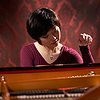Part 2
Could you take me through the process of interpretation on the basis of one of a piece that's particularly dear to you, please? What do you start with when working on a new piece, for example, how do you form your creative decisions and how do you refine them?
I usually have to know what a piece sounds like. So I would either read it through myself or, if it's very complicated, find some reference recording just to get an idea. And once I have that idea, I will listen to anything again until I find I have my own message. With the Scarlatti, for example, there are so many sonatas! I went through them all, and then when I'd finally narrowed down my choices … I don't know if I can put into words what I do. I guess it's in my fingers. You master the technical parts first. And then you find the scheme of the piece, like how many bars are in a phrase, where is the climax? Very basic stuff. And then there are many days in the learning process, where it'll sound really good. And the next day, it will seem like I've lost the feeling. And then you just let it rest for a little while and come back with fresh eyes. The most important thing for me is that whatever I'm doing is within the realm of what the composer wants. You never want to go overboard to look for a different interpretation. Nowadays, everything has been done, everything has been recorded. To find something different in a piece is extremely difficult. Unless you're specifically trying to do something different or to be different. I guess I try to share my message in a very direct way, as natural as possible.
For the Scarlatti double CD, I created my own baroque suites and sonata forms and seeing his sonatas as movements. With Scarlatti, I think you sometimes need that. Otherwise, after listening to a few, your ears can get a little dull. They're all different, yet they're all somehow similar. And I wanted to create bigger forms, so people could have more of an arch to listen to. I was taking liberties. But then, Scarlatti was a person who experimented. He did a lot of things that were not acceptable composition-wise. I like to imagine he would have liked the idea. (laughs)
I also worked with living composers, like George Rocheberg, who has by now passed away. I played a couple of his works for him. I knew him in his final years. It helped me a lot, because I realised how open-minded he was! Many times, he'd say – “oh, that's a good idea, I like the way you did that! You should do that!” There's no real black and white, there's so much gray area to interpretation. It's a question of respect also. How much you respect the composer and how much you're willing to go beyond what he asked for.
I had the honour of doing a world premiere last year in Darmstadt with a composer called Cord Meijering. He wrote a piece for the Darmstadt Stadtorchester and it was a story based on the goddess Isis. He was writing the piece specifically for me and the orchestra, so many times he would ask me what influences you? What is the music you like to listen to? And he would try to make a piece that would suit my taste. And when it came down to rehearsing, he was so open to trying new things. Of course he gave his ideas. Maybe in this place he wanted a bit more articulation, maybe a bit dryer. But he was so open also. He was interested in how his piece can be interpreted. And I would like to think that all composers like that. They must be so happy that their music is being performed. If I were a composer, I would love to hear different possibilities! I might have my preferences, but it's so interesting.
With more and more musicians creating than ever, what does this mean for you as an artist in terms of originality? What are some of the areas where you currently see the greatest potential for originality and who are some of the artists and communities that you find inspiring in this regard?
That's precisely why I avoid listening to too many people, because I don't want to have that influence. I don't want to have the feeling when I'm learning a piece that I could do something in a particular place because I have that image. Music is such a contagious thing. I teach a little bit now and maybe a student will have a problem in a place where I've never had problems myself. And maybe the next day, I'll realise I'm having problems, too. It's so subconscious. You hear something and it stays in your mind.
For quite a long time, improvisation was an integral part of what we now refer to as 'classical music'. Over the course of the 20th century, there have been various attempts of reviving that tradition. How much room for improvisation is there within your own approach and how do you approach it?
Improvisation only plays a role for me in certain Mozart concertos. But I think composition and improvisation are things you have to start when you're a bit younger. You need to at least have had that possibility. And I never did it. And I only started trying something in that direction when I was about 20. I lost that flexibility, I lost that creativity. Or I never found it (laughs). I don't play my own cadenzas – no. I do play my own Übergänge, though. The tiny little bridges, a few bars.
Recordings have always been a hotly debated subject in classical music. What are some of the quality criteria for a good recording from your perspective, what role can technology play and in which way will a recording even allow you to approach a piece from an entirely different perspective?
It's an expression, a sound. You want to capture a specific mood. And it's definitely not about cutting. I really think that, right now, the technology is perhaps too strong. It's too good. You can do anything. With many pianists, I will hear them live and then on recording, and it's just not them. And that takes away a lot. And on some of the older recordings, like Alfred Cortot, his performance of Liszt's St Francis, the audio quality is not as high, but the sound, the image is so much more vivid. And that's what I want to do. Of course, it's not possible to just have one-takes. There will be cuts. But I want to keep the mood in check, so that you don't feel like this is a kind of mish-mash.
Usually, a one-take will form the basis for a recording. For the Scarlatti CD, I definitely want to have one main take with a few little adjustments in certain modes or things. If there are more cuts than two within such a short timespan, you can already hear it.
I had the same team as for the first. The producer was always the same - Renate Wolter-Seevers and she's fantastic. She's part of the Radio Bremen team. She has such an ear! Recording my first CD was such an experience and she walked me through it. She made me feel comfortable and made me realise many things that I wasn't aware of. I think I learned more during the recording session than in preparing the pieces. You find yourself listening to things that you were never listening to before. And the experimenting that we did was very special. I was never one of the pianists who has a tape recorder and records herself. But you listen to yourself differently when you're at the piano as to when you're in the studio. Almost every track I would go and have a listen. I'm not so much involved in the actual finding of the balance, though. Renate's ear was so good.
I like a live feeling for a recording, because it gives it excitement. That's also why you don't want to record something 5,6 times in a row. It then becomes something of a chore. You do want to get do it again, but you also want to do it fresh. Fresh fingers, as well as a fresh mind. If something wasn't working, I would say, we move on and then come back to it a couple hours later. And almost always it would come back in a better way.








